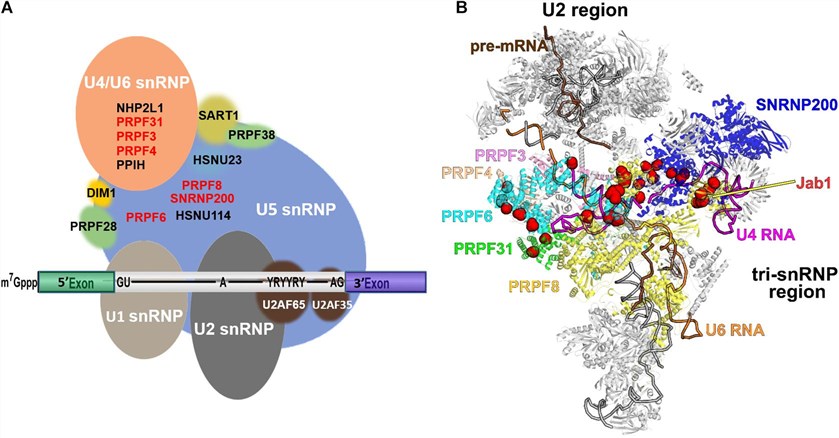What is PRPF4 Protein
PRPF4, which stands for Pre-MRNA Processing Factor 4, is a protein encoded by the PRPF4 gene found in humans. The PRPF4 gene plays a crucial role in producing this protein, which forms an integral component of the spliceosome, the molecular machine for splicing pre-mRNA molecules in a cell.
Function of PRPF4 protein
The PRPF4 protein's central function revolves around ensuring correct splicing of pre-mRNA molecules. Splicing is a modification of an RNA or mRNA after transcription, during which the introns are removed and exons are joined. This process is crucial as it enables gene regulation and maintains stability in the genetic control mechanisms. PRPF4 forms part of the U4/U6.U5 tri-snRNP complex in the spliceosome, a complex responsible for recognizing splice sites on the pre-mRNA.

Fig 1. The structures of spliceosome complex B and tri-snRNP. (Yang, C. et al. 2021)
PRPF4 protein related signal pathway
The PRPF4 protein is involved in a neurobiological signal pathway. The signal pathway associated with PRPF4 links to the spliceosomes' function, referring to the intricate cellular and molecular routes that the PRPF4 protein works through to facilitate mRNA splicing – the creation of mature RNA molecules.
PRPF4 protein related diseases
Disturbances in the PRPF4 protein's functioning or mutations in the PRPF4 gene can lead to potentially dangerous diseases. A significant disease related to PRPF4 protein malfunction is Retinitis Pigmentosa (RP). RP is a group of rare genetic disorders that involve a breakdown and loss of cells in the retina, leading to progressive vision loss. The PRPF4 gene mutations can disrupt the functioning of the retinal cells, which engenders markers of RP. Other diseases associated with the PRPF4 gene include Usher syndrome and Leber congenital amaurosis, both profound vision loss diseases as well.
Furthermore, there is a potential link between the PRPF4 protein and certain types of cancers due to the protein's crucial role in the cell's mRNA splicing mechanism. Splicing irregularities have been observed in various cancers, and the dysfunctional splicing could potentially be due to alterations in spliceosome components, including PRPF4.
PRPF4 protein's applications in biomedical
Due to its critical role in mRNA splicing and thus protein synthesis, the PRPF4 protein has significant potential applications in the biomedical field. For instance, understanding the behavior and functioning of PRPF4 can substantially aid in targeted genetic therapy. As PRPF4 is associated with disorders like RP, understanding the PRPF4 mutation patterns and developing mechanisms to rectify them can form the basis of gene therapy for RP.
The PRPF4 protein could also serve as an important biomarker acknowledging, diagnosing, and treating certain types of cancers. Since mRNA splicing irregularities occur in numerous cancers, monitoring the PRPF4 protein could provide valuable insights into tumorigenic processes and potentially introduce novel therapeutic interventions.
Moreover, the potential to manipulate the splicing mechanism, where PRPF4 is abundantly involved, offers exciting prospects for genetic engineering and biomedical research. For example, it might be possible to use knowledge of the PRPF4 protein function to create drugs that target the spliceosome or other components of the gene-regulation mechanism to treat diseases.
Despite our still growing knowledge about PRPF4 protein and its implications towards health and disease, it's undoubtedly clear that its role within cellular machinery is critical for understanding, diagnosing, and combating a range of genetic diseases. By harnessing the power of biomedical science, we can continue to explore this protein's potential and utilize it in our ongoing quest for advancements in human health.
Our Featured Products
| Cat.No. | Product Name | Species | Source (Host) | Tag |
|---|---|---|---|---|
| PRPF4-1976H | Recombinant Human PRPF4, GST-tagged | Human | E.coli | GST |
| PRPF4-4811H | Recombinant Human PRPF4 Protein, Myc/DDK-tagged, C13 and N15-labeled | Human | HEK293T | Myc/DD |
| Prpf4-5147M | Recombinant Mouse Prpf4 Protein, Myc/DDK-tagged | Mouse | HEK293T | Myc/DDK |
| PRPF4-3443R | Recombinant Rhesus Macaque PRPF4 Protein, His (Fc)-Avi-tagged | Rhesus Macaque | HEK293 | His (Fc)-Avi |
Reference
- Yang, C., Georgiou, M., Atkinson, R., Collin, J., Johnson, C., Ali, R., Armstrong, L., & Lako, M. (2021). Pre-mRNA Processing Factors and Retinitis Pigmentosa: RNA Splicing and Beyond. Frontiers in Cell and Developmental Biology, 9, 700276. https://doi.org/10.3389/fcell.2021.700276

